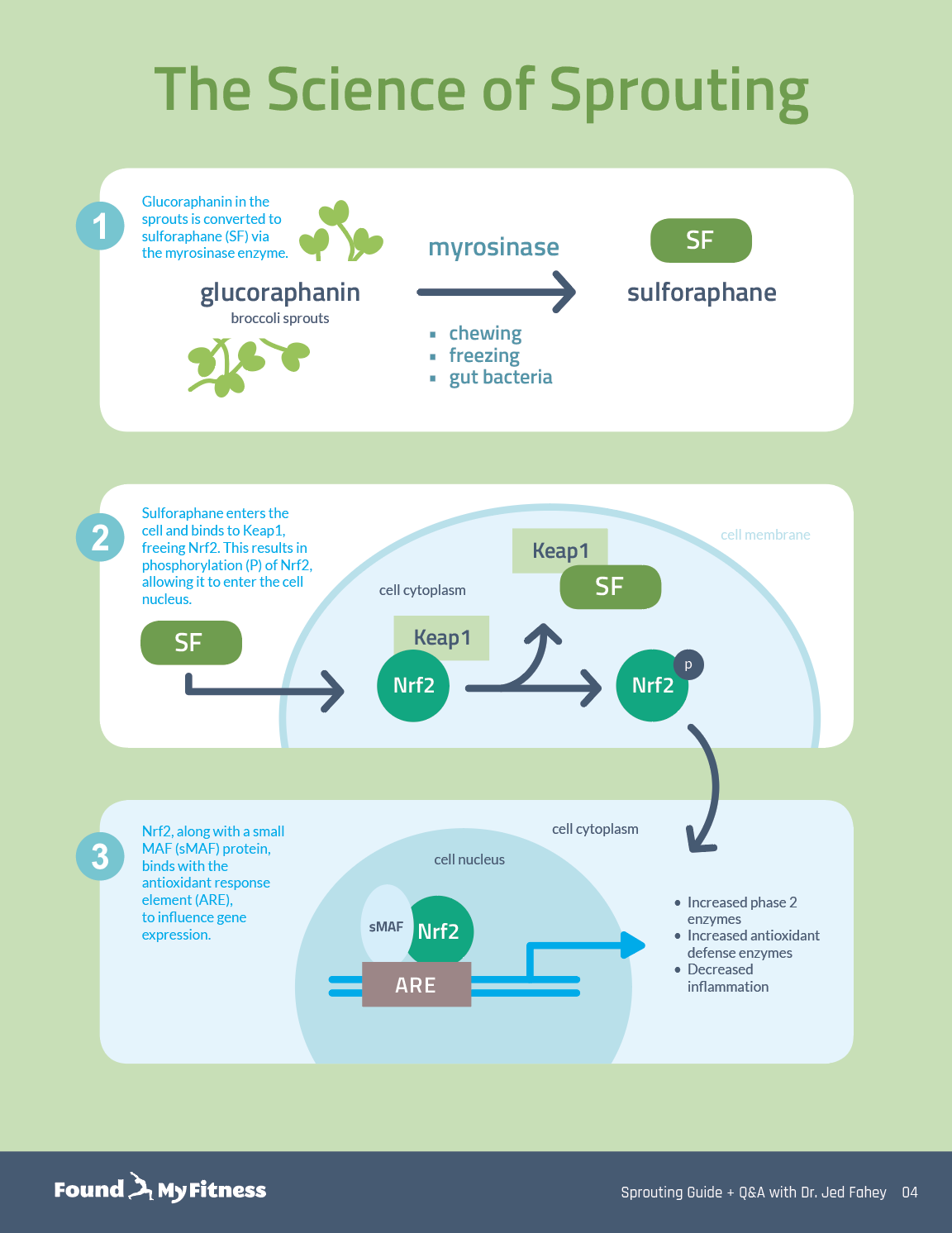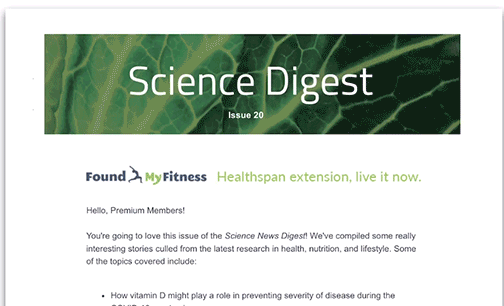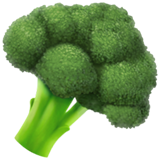How do you maximize glucoraphanin in broccoli sprouts? | Jed Fahey
Enter your email to get our 15-page guide to sprouting broccoli and learn about the science of chemoprotective compount sulforaphane.
Broccoli sprouts are concentrated sources of sulforaphane, a type of isothiocyanate. Damaging broccoli sprouts – when chewing, chopping, or freezing – triggers an enzymatic reaction in the tiny plants that produces sulforaphane.

Get the full length version of this episode as a podcast.
This episode will make a great companion for a long drive.
Optimizing the amount of sulforaphane derived from broccoli sprouts requires multiple strategies, starting with high-quality seeds that are rich in glucoraphanin, the precursor to sulforaphane, and eating the sprouts while they are young. If that isn't possible or practical, freezing them for future use and then blending the frozen sprouts into a preferred food can help ensure the highest quantities of sulforaphane production. In this clip, Dr. Jed Fahey discusses the best protocol for maximizing glucoraphanin levels in broccoli sprouts to obtain the highest concentration of sulforaphane.
[Dr. Patrick]: The next question is, "Broccoli sprouts still the best way to get sulforaphane, how to maximize production in the sprouts? Freeze them, steep them both, let them sit after blending to allow myrosinase to react with the glucoraphanin?"
[Dr. Fahey]: Yeah, so if you're home sprouting and you know what the glucoraphanin content of your seeds are, that's great. But I've already warned you you probably won't be able to know what the content is, it's very difficult to know.
So if you're blending them up, you want to do that just before consuming them. You can't blend up a concoction once a week, and then put it in the refrigerator and go in for a few gulps, you know, every now and then throughout the week. Excuse me. If you freeze them, that's fine. You can blend them and freeze them, and then eat them, immediately eat that "blendate" immediately after thawing, that's fine. If...you know, if you're intent on...
[Dr. Patrick]: Wait, wait. Would you freeze the sprouts, and then blend them immediately after, and then consume them?
[Dr. Fahey]: Honestly, you could do either.
[Dr. Patrick]: Okay.
[Dr. Fahey]: The myrosinase will stay active and start...it won't be reactive in the freezer, probably inactive. But it will start working again when you thaw that paste or whatever, you know, the concoction.
So, you know, if you're intent on getting a specific... If you want to eat healthy and get some sulforaphane, then I think eating broccoli sprouts or smoothies made from them, or, you know, we've talked about some of the modes of delivery, is great. If you want to get a known dose of sulforaphane, then probably you're best to go to a high-quality supplement. But... And then there's the question of commercially grown sprouts, which we maybe can get into in another sort of... This has to do with cleanliness or sanitation of sprouts.
But, so, you know, there's...I think there's more chance of holding manufacturers accountable if you're taking a supplement, or there will be in the future hopefully. If you're just...if you're buying seeds and making your own sprouts, unless you get them tested for glucoraphanin content, you're really not going to know. You're not going to know how active the myrosinase might be in those sprouts either.
That said, I'm not trying to discourage anybody from doing it at all, I think it's a great idea.
[Dr. Patrick]: It's cost-effective, as well, for sure. People...some people can't afford supplements.
[Dr. Fahey]: It's very cost-effective. And if... I need to give a shout-out to my new friend Doug Evans who has this book that he just wrote and it's being translated in multiple languages and it's excellent. It's called The Sprout Book, I think. God, I'm blanking on the name of his book. But he...you know, he advocates sprouts from a nutritional perspective and he does...I think he has a chapter that talks about our work and that of others showing medicinal or preventive qualities of broccoli sprouts.
He was very generous talking about our work, but his bottom line is it's cheap, it's effective, it's highly nutritious. You get all the fiber, you know, you get the vegetable fiber if you eat the sprouts, which you don't get with supplements. And, you know, you get vitamins and you get minerals and blah, blah, blah. But he makes a very good case, I think, for it. And I think he...not to be disrespectful, but I think he lives on sprouts, I don't know if he eats anything but sprouts.
So, but he has some good methodology and he talks about other kinds of sprouts, whereas in the guide that I helped put together for you, Rhonda, we just talked about broccoli sprouts. So yeah.
A glucosinolate (see definition) found in certain cruciferous vegetables, including broccoli, Brussels sprouts, and mustard. Glucoraphanin is hydrolyzed by the enzyme myrosinase to produce sulforaphane, an isothiocyanate compound that has many beneficial health effects in humans.
An essential mineral present in many foods. Iron participates in many physiological functions and is a critical component of hemoglobin. Iron deficiency can cause anemia, fatigue, shortness of breath, and heart arrhythmias.
A family of enzymes whose sole known substrates are glucosinolates. Myrosinase is located in specialized cells within the leaves, stems, and flowers of cruciferous plants. When the plant is damaged by insects or eaten by humans, the myrosinase is released and subsequently hydrolyzes nearby glucosinolate compounds to form isothiocyanates (see definition), which demonstrate many beneficial health effects in humans. Microbes in the human gut also produce myrosinase and can convert non-hydrolyzed glucosinolates to isothiocyanates.
An isothiocyanate compound derived from cruciferous vegetables such as broccoli, cauliflower, and mustard. Sulforaphane is produced when the plant is damaged when attacked by insects or eaten by humans. It activates cytoprotective mechanisms within cells in a hormetic-type response. Sulforaphane has demonstrated beneficial effects against several chronic health conditions, including autism, cancer, cardiovascular disease, diabetes, and others.
Volatile organic compound. An organic chemical that has a high vapor pressure at ordinary room temperature.
Get email updates with the latest curated healthspan research
Support our work

Every other week premium members receive a special edition newsletter that summarizes all of the latest healthspan research.
Sulforaphane News
- Broccoli seed extract with a sulforaphane precursor reduced common cold symptom days in healthy adults.
- Sulforaphane-rich broccoli sprout extract modestly lowers fasting blood sugar in some people with prediabetes, perhaps due to variations in gut microbiota and individual metabolic traits.
- Sulforaphane, derived from broccoli, activates Nrf2, mitigating age-related skin changes and boosting the antioxidant defense system in mice.
- Sulforaphane from broccoli sprouts shows promise in preventing Alzheimer's disease – boosting memory and enhancing mitochondrial function in mice.
- Breathwork enhances endogenous antioxidant enzyme activity to counter oxidative stress.






